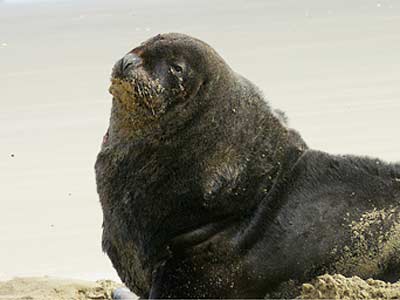New Zealand, 2008
Pages 1 | 2 | 3 | 4 | 5 | 6 | 7 | 8 | 9 | 10
11 | 12 | 13 | 14 | 15 | 16 | 17 | 18 | 19 | 20
The Catlins and Cathedral Cave
We awoke on Saturday, February 3, to much better weather, so we set out
from Invercargill. The first thirty or so kilometres east fof the city
were relatively flat and not terribly interesting, but the terrain began
to roll as we approached Fortrose.
|
Flat terrain outside Invercargill |
Mataura River, between Invercargill and Fortrose |
We were bound for the Catlins, a hilly area along the southeast coast of New Zealand. It has been isolated and little visited until recent years. Now, to some degree, it has been opened up for eco-tourism, but it is still remarkably unspoiled, populated mainly by sheep. |
We chose the southernmost, coastal route and entered the Catlins in earnest. Headlands sloped down to the shore, sometimes requiring difficult climbs and offering fast descents too. But at least the road was paved — until 14 kilometres before Curio Bay, our destination for our first night in the Catlins. Then things got tough for us, because our recumbent bikes are not great on hills anyway, and when loose gravel is added, it gets pretty awful. Fortunately there was somewhat less loose gravel in the second half of the unpaved section. Anyway, we made it to Curio Bay without a fall after 75 kilometres of challenging cycling.
|
Reaching the sea near Fortrose |
Into the Catlins |
Onto the gravel and into the hills
| Curio Bay is a special place because Hectors Dolphins, the smallest and among the rarest dolphin species, play regularly close-in to the beach. They sometimes surf the waves here, and they also approach swimmers. A few people went into the water to be with the dolphins while we were there, but it was too cold and windy for us. |
Wind-whipped water at Curio Bay |
The bay at dawn
Also, yellow-eyed penguins breed here at Curio Bay, and it is usually possible to see them clearly as they come ashore and toddle to their nests. They are so cute!
|
|
|
Perhaps the only negative thing we can say about New Zealand so far concerns the large campground at Curio Bay. The campsites themselves are fine, but the facilities are totally inadquate for the number of campers, and their condition is a disgrace. People come here and enjoy it, as we did, because the setting is so extraordinary, but the campground desperately needs to be upgraded.
We might possibly have stayed another night at Curio Bay, but because
we have become totally spoiled and now expect great facilities at campgrounds,
we decided to push on. Sunday we rode only 45 kilometres to another, incomparably
better campground at MacLean's Falls. The MacLean's Falls campground was
near two attractions: the falls, and the Cathedral Caves. Because there
has been so little rain, the water flow at the falls was severely diminished
so we decided not to bother going there — a ride on gravel and then
a hike.
| We did, however, go to Cathedral Caves, which had
been highly recommended by Roger and Val in Christchurch. The road
in was gravel again, and steep at first, so we left our bikes at the
entry and bummed a ride with a nice New Zealand couple. When we all
reached the beach, they pointed out a sea lion in the distance. We'd
have taken it for an old log or lump of seaweed, it was so inert.
But we walked closer, and he stirred to life. |
Arriving at the beach by Cathedral Caves |
|
Everyone keeps an eye on the sea lion. |
 Sorry to wake you. |
|
On the right, Cathedral Caves from
a distance. We enter the cave on left and come out on the right.
This is possible only at low tide, of course.
|
|
|
Going in |
Coming out |